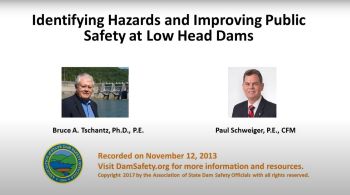Public Safety: Difference between revisions
No edit summary Tag: Reverted |
No edit summary Tag: Manual revert |
||
| Line 31: | Line 31: | ||
{{Citations}} | {{Citations}} | ||
<!-- Revision history information --> | <!-- Revision history information --> | ||
{{revhistinf}} | {{revhistinf}} | ||
Revision as of 23:38, 26 January 2023

|
| Learn more about public safety at dams from this free webinar |
Conditions may exist at or near dams and hydraulic structures that could be dangerous or conducive to accidents that could cause injury or loss of life. Dam owners, engineers inspecting and designing dam modifications, regulators and others working around dams need to understand the hazards posed to the public by the presence and operations of dams and levees and be aware of their responsibility for addressing, managing, and when possible eliminating these public safety risks. When possible, the hazard should be completely mitigated by modifying a dam to remove the hazard. When not possible, mitigation measures can include restrictions to entry (fencing) and signage. Public safety education particularly with young people is another strategy to prevent deaths or injuries at these dams.
- Legal Responsibilities (Public Safety)
- Risk Assessment (Public Safety)
- Risk Mitigation (Public Safety)
- Public Safety Program Management
Examples
![]() Learn more about the need to address public safety at dams at DamFailures.org
Learn more about the need to address public safety at dams at DamFailures.org
Best Practices Resources
![]() Dam Safety Warning Signs Best Practices (FEMA P-2188), FEMA, 2021
Dam Safety Warning Signs Best Practices (FEMA P-2188), FEMA, 2021
![]() Guidelines for Public Safety at Hydropower Projects, FERC, 1992
Guidelines for Public Safety at Hydropower Projects, FERC, 1992
Trainings
![]() On-Demand Webinar: Introduction to Public Safety Risk Evaluation and Treatment for Dams and Levees
On-Demand Webinar: Introduction to Public Safety Risk Evaluation and Treatment for Dams and Levees
![]() On-Demand Webinar: Identifying Hazards and Improving Public Safety at Low Head Dams
On-Demand Webinar: Identifying Hazards and Improving Public Safety at Low Head Dams
![]() YouTube: Identifying Hazards and Improving Public Safety at Low Head Dams
YouTube: Identifying Hazards and Improving Public Safety at Low Head Dams
Citations:
Revision ID: 6491
Revision Date: 01/26/2023
